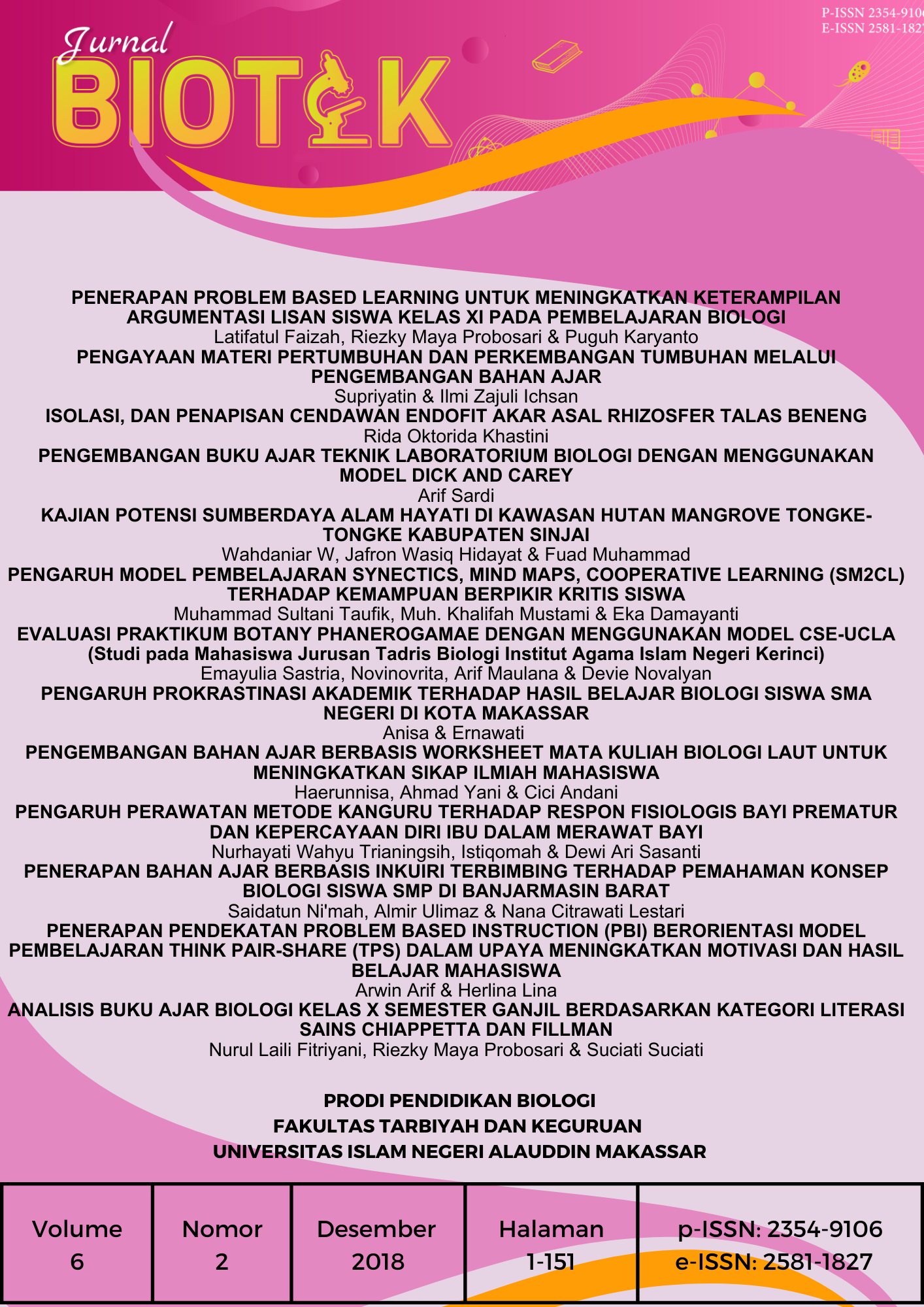EVALUASI PRAKTIKUM BOTANY PHANEROGAMAE DENGAN MENGGUNAKAN MODEL CSE-UCLA (Studi pada Mahasiswa Jurusan Tadris Biologi Institut Agama Islam Negeri Kerinci)
Abstrak
One of the ways to maximize the practicum function carried out in lectures is through the evaluation of practicum programs. So far there has never been an evaluation on practicum, which only focuses on the implementation of the practicum itself. There are many program evaluation models designed by experts. These models tend to be developed in accordance with the objectives of evaluation. One of them is the CSE program evaluation model UCLA. This study aims to find out assessment systems, program planning, implementation programs and certification certification programs Botany phanerogamae students majoring in biology IAIN Kerinci. This research belongs to the category of qualitative research which includes the type of case study method (case study). To get the CSE-UCLA model data, researchers used observational studies, documents and interviews. At the stage of the assessment assessment system has been owned and implemented, although there are obstacles to the lack of student attention to the environment. At the planning stage, the program focuses on evaluating the feasibility of the organizational structure of the Department of Biology, evaluating the readiness of the ability of lecturers and assistants, advice and infrastructure and labor managers in the Botany Phanerogamae Practicum which is categorized ready. In the Implementation Program stage it has been carried out well and also structured. The Improvement Program has been categorized as effective. In the Certification Program stage it is in accordance with the wishes of the Department of Biology. Where the practicum objectives and responses of the students are very positive, so that the stages of practicum implementation can run effectively and in accordance with the expected desires of the Department of Biology of the Kerinci Islamic Institute.
Keywords: System assessment, program planning, implementation programs, program certification and Botanical phanerogamae.
##plugins.generic.usageStats.downloads##
Referensi
Bambang Triatmodjo, 1996, Pelabuhan. Beta Offset, Yogyakarta.
Divayan, Dewa Gede H. dan Gusti Ayu Dessy S. 2016.Evaluasi program sertifikasi komputer pada Universitas Teknologi Indonesia menggunakan model CSE-UCLA. ISSN: 2303-288X, Vol. 5, No. 2.
Divayana, D.G.H. 2017 Evaluasi Pelaksanaan Blended Learning di SMK TI Udayanana menggunakan Model CSE-UCLA. Volume 7 No. 1
Djamarah, Syaiful Bahri & Aswan Zein.2014. Strategi Belajar Mengajar. Jakarta: PT. Rineka Cipta
Efyanti, Yasni. Bimbingan Skripsi Mahasiswa Stain Kerinci. STAIN Kerinci
Imami Nur.R. 2017.Pengumpulan Data dalam Penelitian Kualitatif. Vol. 11. No. 1.
J.R.Raco. 2010.Metode Penelitian Kualitatif Jenis, Karakteristik, dan Keunggulannya.Jakarta : PT.Gramedia Widiasarana Indonesia.
Moleong. 1989. Metodologi Penelitian Kualitatif. Bandung: PT. Remaja Rosdakarya
Munthe, Ashiong, P. Pentingnya Evaluasi Program di Institusi Pendidikan. Scholaria, Vol.5.No.2. Mei 2015
Riduwan. 2009. Belajar Mudah Penelitian. Bandung : Alfabeta
Rustaman, A. 2005. Pengembangan Kompetensi (Pengetahuan, Keterampilan, Sikap dan Nilai melalui Kegiatan Praktikum Biologi. Penelitian Jurusan Pendidikan Biologi FPMIPA UPI Bandung.
Rustaman, N.2010. Peranan Praktikum dalam pembelajaran IPA. Diakses tanggal 5 November 2017
Stufflebeam & Shinkfield. 2007. The Joint Committee’s
Sugiyono. 2009. Metode Penelitian Pendidikan pendekatan Kuantitatif, Kualitatif, dan R&D. Bandung : Alfabeta
Suharsimi, Arikanto. 2008. Dasar – Dasar Evaluasi Pendidikan. Jakarta: Bumi Aksara
Wand, Edwin & Gerald W.Brown. Essential of Education Evaluation. Paperback Import December 1957.
##submission.copyrightStatement##
##submission.license.cc.by-sa4.footer##Authors who publish with Jurnal Biotek agree to the following terms: Authors retain the copyright and grant Universitas Islam Negeri Alauddin Makassar right of first publication with the work simultaneously licensed under a Creative Commons Attribution License (CC BY-SA 4.0) that allows others to share (copy and redistribute the material in any medium or format) and adapt (remix, transform, and build upon the material) the work for any purpose, even commercially with an acknowledgement of the work's authorship and initial publication in Universitas Islam Negeri Alauddin Makassar. Authors are able to enter into separate, additional contractual arrangements for the non-exclusive distribution of the journal's published version of the work (e.g., post it to an institutional repository or publish it in a book), with an acknowledgement of its initial publication in Universitas Islam Negeri Alauddin Makassar. Authors are permitted and encouraged to post their work online (e.g., in institutional repositories or on their website) prior to and during the submission process, as it can lead to productive exchanges, as well as earlier and greater citation of published work (See The Effect of Open Access).

This work is licensed under a Creative Commons Attribution-ShareAlike 4.0 International License.



